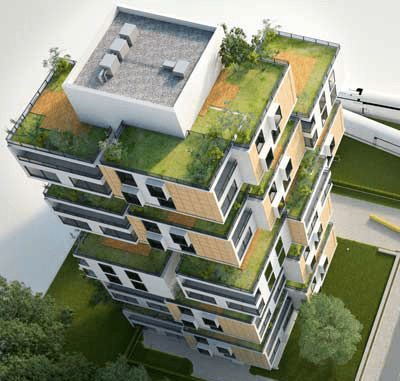Teenu J Thaikattil
Alliance for an Energy Efficient Economy,
New Delhi, India
Corresponding Author: teenu@aeee.in
Snowy Christophel
Department of Environment and Climate Change, Govt. of Tamil Nadu, Chennai, India
Josna Raphael
School of Architecture & Planning, Govt. Engineering College Thrissur, Thrissur, India
Cite this article
Highlights
- A top-down approach for sectors and a bottom-up approach to integrating local knowledge and indigenous measures are vital for sustainable low-carbon development.
- Among 128 Indian cities analyzed, only 10 have comprehensive sectoral approaches for city climate action.
- Adopt performance-based codes for local area plans, replacing conventional zoning and form-based codes for climate action.
- Low-carbon design strategies are identified from urban design concepts, which can be used in design for achieving low-carbon development at the neighborhood scale.
Abstract
India has committed to addressing climate change through its Nationally Determined Contributions (NDC) and has set a target of achieving net-zero emissions by 2070. The National Action Plan on Climate Change (NAPCC) Low carbon strategies for Long-Term Low Emission Development Strategy (LT-LEDS) and State Action Plans on Climate Change (SAPCCs) provide a framework for addressing climate change. However, there is a lack of emphasis on climate change action in the development plans of urban local bodies. This research aims to extend the findings from government documents at the city scale that are aligned with SAPCCs in promoting low-carbon development and explore how urban design can be utilized by local governments to integrate climate action plans into local area development plans. The study analyses city climate-related documents from 128 cities in India and proposes various urban design interventions to achieve low-carbon development goals.
Keywords
Low Carbon Development, Urban Design, City Climate Action Plans, Local Area Plan’, Performance-Based Code.
References
- U. Nations, ‘Generating power’, United Nations. https://www.un.org/en/climatechange/climatesolutions/cities-pollution
- ‘Urban Resilience – Urbanisation’. https://www.teriin.org/resilient-cities/urbanisation.php
- United Nations Environment Programme, ‘A framework for shaping sustainable lifestyles: determinants and strategies’, 2016, [Online]. Available: https://wedocs.unep.org/20.500.11822/9995
- S. Byravan and S. Rajan, ‘An evaluation of India’s national action plan on climate change’, SSRN Electronic Journal, Jan. 2013. https://doi.org/10.2139/ssrn.2195819
- K. Yagnik et al., ‘Guidebook: how to develop a climate action plan for cities in India’, JRC Publications Repository, Jun. 14, 2022. https://publications.jrc.ec.europa.eu/repository/handle/JRC128749
- ‘India_LTLEDS.pdf’. Accessed: Jun. 08, 2023. [Online]. Available: https://unfccc.int/sites/default/files/resource/India_LTLEDS.pdf
- ‘Regions of India in each climate zones and climate type.’, ResearchGate. https://www.researchgate.net/figure/Regions-of-India-in-each-climate-zones-and-climatetype_tbl1_346002665
- D. Dugaya et al., ‘Carbon sequestration potential of trees planted along roadsides: A case from Bhopal city, India’, Int. J. Environ., vol. 9, no. 2, Art. no. 2, Oct. 2020 . https://doi.org/10.3126/ije.v9i2.32537
- R. Khosla and A. Bhardwaj, ‘Urbanization in the time of climate change: Examining the response of Indian cities’, WIREs Climate Change, vol. 10, no. 1, p. e560, 2019. https://doi.org/10.1002/wcc.560
- ‘What is the Kyoto Protocol? | UNFCCC’. https://unfccc.int/kyoto_protocol
- R. S. Dimitrov, ‘The Paris Agreement on Climate Change: Behind Closed Doors’, Global Environmental Politics, vol. 16, no. 3, pp. 1-11, Aug. 2016. https://doi.org/10.1162/GLEP_a_00361
- D. Bodansky, ‘A Tale of Two Architectures: The once and future U.N. climate change regime’, in Climate Change and Environmental Hazards Related to Shipping: An International Legal Framework, Brill Nijhoff, 2013, pp. 35-51. https://doi.org/10.1163/9789004244955_005
- ‘The Paris Agreement | UNFCCC’. https://unfccc.int/process-and-meetings/the-paris-agreement
- A. Huovila et al., ‘Carbon-neutral cities: Critical review of theory and practice’, J. Cleaner Prod., vol. 341, p. 130912, Mar. 2022. https://doi.org/10.1016/j.jclepro.2022.130912
- S. Kennedy and S. Sgouridis, ‘Rigorous classification and carbon accounting principles for low and Zero Carbon Cities’, Energy Policy, vol. 39, no. 9, pp. 5259-5268, Sep. 2011. https://doi.org/10.1016/j.enpol.2011.05.038
- P. Zhou, ‘Low-Carbon Development’, in Encyclopedia of Quality of Life and Well-Being Research, A. C. Michalos, Ed., Dordrecht: Springer Netherlands, 2014, pp. 3723-3725. https://doi.org/10.1007/978-94-007-0753-5_3382
- C. L. Choguill, ‘Developing sustainable neighbourhoods’, Habitat International, vol. 32, no. 1, pp. 41-48, Mar. 2008. https://doi.org/10.1016/j.habitatint.2007.06.007
- E. Rey, M. Laprise, and S. Lufkin, ‘Sustainability issues at the neighbourhood scale’, in Neighbourhoods in Transition: Brownfield Regeneration in European Metropolitan Areas, E. Rey, M. Laprise, and S. Lufkin, Eds., in The Urban Book Series. Cham: Springer International Publishing, 2022, pp. 77-93. https://doi.org/10.1007/978-3-030-82208-8_5
- A. Sharifi and A. Murayama, ‘A critical review of seven selected neighborhood sustainability assessment tools’, Environ. Impact Assess. Rev., vol. 38, pp. 73-87, Jan. 2013. https://doi.org/10.1016/j.eiar.2012.06.006
- N. Joshi, S. Agrawal, and S. Lie, ‘What does neighbourhood climate action look like? A scoping literature review’, Clim Action, vol. 1, no. 1, p. 10, May 2022. https://doi.org/10.1007/s44168-022-00009-2
- J. M. Wittmayer, N. Schäpke, F. van Steenbergen, and I. Omann, ‘Making sense of sustainability transitions locally: how action research contributes to addressing societal challenges’, Crit. Policy Stud., vol. 8, no. 4, pp. 465-485, Oct. 2014. https://doi.org/10.1080/19460171.2014.957336
- X. Wang, G. Zhao, C. He, X. Wang, and W. Peng, ‘Low-carbon neighborhood planning technology and indicator system’, Renew. Sustain. Energy Rev., vol. 57, pp. 1066-1076, May 2016. https://doi.org/10.1016/j.rser.2015.12.076
- H. Panwar, “City Climate Action Plan: Climate Smart Cities – Assessment Framework Urban Planning, Green Cover & Biodiversity,” National Institute of Urban Affairs (NIUA), New Delhi, India, Dec. 2021. https://niua.in/c-cube/sites/all/themes/zap/pdf/climate-action-plan.pdf
- ’75.pdf’. [Online]. Available: https://niua.in/intranet/sites/default/files/75.pdf
- Manual for Preparation of Local Area Plans, Government of Gujarat, 2022. [Online]. Available: https://crdf.org.in/resources/admin_uploads/resources/LAP%20Manual.pdf
- S. Maiti and J. V. De Faria, ‘Participatory planning processes in Indian cities: its challenges and opportunities’, J. Sustain. Urbaniz. Plan Prog., vol. 2, no. 1, May 2017. https://doi.org/10.18063/JSUPP.2017.01.001
- C. Moreno, Z. Allam, D. Chabaud, C. Gall, and F. Pratlong, ‘Introducing the “15-Minute City”: Sustainability, Resilience and Place Identity in Future Post-Pandemic Cities’, Smart Cities, vol. 4, no. 1, Art. no. 1, Mar. 2021. https://doi.org/10.3390/smartcities4010006
- R. L. Knowles, ‘The solar envelope: its meaning for energy and buildings’, Energy Build., 2003. https://doi.org/10.1016/S0378-7788(02)00076-2
- J. Parker and G. D. Simpson, ‘A case study balancing predetermined targets and real-world constraints to guide optimum urban tree canopy cover for Perth, Western Australia’, Forests, vol. 11, no. 11, Art. no. 11, Nov. 2020. https://doi.org/10.3390/f11111128
- D. Slanger, ‘India’s buildings sector moonshot: Corporate climate commitments can forge the path’, RMI, Jun. 08, 2021. https://rmi.org/indias-buildings-sector-moonshot-corporate-climatecom1mitments-can-forge-the-path/
- ‘C40 RfP Healthy and efficient buildings’ Literature and Vulnerability Mapping Review. [Online]. Available: https://www.c40.org/wp-content/uploads/2022/04/C40_RfP_Healthy-and-Efficient-buildings_Literature-and-Vulnerability-Mapping-Review.pdf
- ‘Superblocks in urban planning’, Topos Magazine. https://toposmagazine.com/superblocks-inurban-planning/
- I. López, J. Ortega, and M. Pardo, ‘Mobility infrastructures in cities and climate change: An analysis through the superblocks in Barcelona’, Atmosphere, vol. 11, no. 4, Art. no. 4, Apr. 2020. https://doi.org/10.3390/atmos11040410
- B. Mondal, K. Bauddh, A. Kumar, and N. Bordoloi, ‘India’s contribution to greenhouse gas emission from freshwater ecosystems: A comprehensive review’, Water, vol. 14, no. 19, Art. no. 19, Jan. 2022. https://doi.org/10.3390/w14192965
- D. Jato-Espino, E. I. Toro-Huertas, and L. P. Güereca, ‘Lifecycle sustainability assessment for the comparison of traditional and sustainable drainage systems’, Science of The Total Environment, vol. 817, p. 152959, Apr. 2022. https://doi.org/10.1016/j.scitotenv.2022.152959
- M. Gautam and M. Agrawal, ‘Greenhouse gas emissions from municipal solid waste management: A review of global scenario’, in Carbon Footprint Case Studies: Municipal Solid Waste Management, Sustainable Road Transport and Carbon Sequestration, S. S. Muthu, Ed., in Environmental Footprints and Eco-design of Products and Processes. Singapore: Springer, 2021, pp. 123-160. https://doi.org/10.1007/978-981-15-9577-6_5
- ‘Low carbon city: a guidebook for city planner and practitioners’ UN Environment Programme, 2013. https://www.unep.org/resources/report/low-carbon-city-guidebook-city-planner-and-practitioners
- M. Chàfer, F. Sole-Mauri, A. Solé, D. Boer, and L. F. Cabeza, ‘Life cycle assessment (LCA) of a pneumatic municipal waste collection system compared to traditional truck collection. Sensitivity study of the influence of the energy source’, Journal of Cleaner Production, vol. 231, pp. 1122- 1135, Sep. 2019. https://doi.org/10.1016/j.jclepro.2019.05.304
- J. A. Farré, C. Mateu, M. Teixidó, and L. F. Cabeza, ‘Pneumatic urban waste collection systems: A review’, Applied Sciences, vol. 13, no. 2, Art. no. 2, Jan. 2023. https://doi.org/10.3390/app13020877
- Copenhagen Solutions for Sustainable Cities, January 2014, 3rd edition, City of Copenhagen, City Hall, 1599 København V.
- ‘City Policy Framework for Dramatically Reducing Embodied Carbon, 2020’. Carbon Neutral Cities Alliance. https://www.embodiedcarbonpolicies.com/download-city-policy-framework
- Y. Shu, J. Chen, Y. Huang, and W. Fu, ‘Sustainable approaches to realize carbon neutrality in China: A case study of Zhejiang province’, J. Mar. Sci. Eng., vol. 10, no. 10, Art. no. 10, Oct. 2022. https://doi.org/10.3390/jmse10101351
- R. Koide et al., ‘Lifestyle carbon footprints and changes in lifestyles to limit global warming to 1.5 °C, and ways forward for related research’, Sustain Sci, vol. 16, no. 6, pp. 2087-2099, Nov. 2021. https://doi.org/10.1007/s11625-021-01018-6
- ‘LEDS in Practice: Ensure energy security’, Global Climate Action Partnership. https://globalclimateactionpartnership.org/resource/leds-practice-ensure-energy-security/

 Bishal Thapa
Bishal Thapa





 Fred Sherman
Fred Sherman Sumedha Malaviya
Sumedha Malaviya Satish Kumar
Satish Kumar












 The three main global energy concerns of providing access to modern energy, enhancing the security of the energy supply, and minimising the impact of energy systems on the climate have an impact on both national and international energy governance. To develop solutions that address the many facets of these difficulties, however, a variety of actors and stakeholders must be included due to the complexity of the energy challenges.
The three main global energy concerns of providing access to modern energy, enhancing the security of the energy supply, and minimising the impact of energy systems on the climate have an impact on both national and international energy governance. To develop solutions that address the many facets of these difficulties, however, a variety of actors and stakeholders must be included due to the complexity of the energy challenges. Cities are responsible for more than 70% of the world’s energy consumption and 40% to 50% of its greenhouse gas emissions. Managing increasing urbanisation is a challenge, and nations must deal with the effects it will have on the environment in terms of energy and climate.
Cities are responsible for more than 70% of the world’s energy consumption and 40% to 50% of its greenhouse gas emissions. Managing increasing urbanisation is a challenge, and nations must deal with the effects it will have on the environment in terms of energy and climate. Our transition to a future with lower carbon emissions depends heavily on buildings. They are our places of residence, rest, and employment; they also account for around one-third of the world’s greenhouse gas emissions and nearly 40% of the world’s energy usage.
Our transition to a future with lower carbon emissions depends heavily on buildings. They are our places of residence, rest, and employment; they also account for around one-third of the world’s greenhouse gas emissions and nearly 40% of the world’s energy usage.